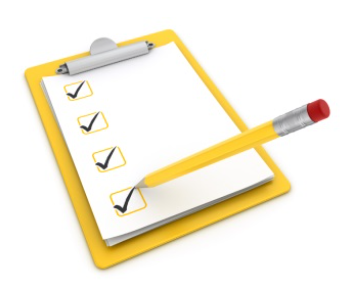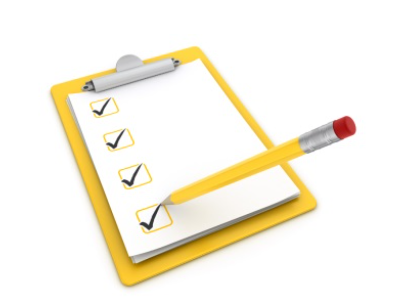Title Page
-
Welcome to Workplace Inspections Program 2023!
001 Location and Composition
-
001/01. Have the detailed locations which this Low Risk Inspection covers been recorded in the "Add note" section?
-
001/02. Have HSRs of the Work Group been invited to participate in this inspection?<br><br>HSRs are elected representatives of workers.<br>List names in the "Add note" section
-
001/03. Has the Authorised Inspector and Inspection Team members been identified in the "Add note" Section?
-
001/04. Have you identified all staff interviewed during the inspection in the "Add note" section?
-
001/05. Have all corrective actions from last inspection been closed in Figtree?
01 Before you Finish
-
01/01. Have Figtree entries for hazards found during this inspection been raised?
-
01/02. Were any other new identified hazards or risks identified during this inspection?
Emergency Management (1)
-
2. Are evacuation signs, displayed at all exit doors, in good condition?
-
3. Are all evacuation diagrams compliant with Australian Standard AS3745:2010 planning for emergencies in facilities PART 3.5?
-
4. Are Emergency Flip Charts available within easy reach of every fixed phone?
-
5. Are current Key Emergency Personnel Charts displayed on noticeboards, at entrances to buildings, at Fire Indicator panel FIP, and WIP Phone locations? - Check version control
-
6. Are Fire extinguishers available and the correct type for possible fires? - Fire extinguishers should be colour coded for contents and contents should match signage
-
7. Is Fire Extinguisher signage installed as per AS2444?<br><br>1. Fire extinguisher identification signs must be located above or adjacent each extinguisher.<br>2. It is compulsory to position a location sign at least 2m from the floor or situated so it is clearly visible to a person of average height
-
8. Have all fire extinguisher test tags been stamped within past 12 months?
-
9. Is area around fire extinguishers clear of items?<br><br>Clearway area marked with yellow lines of 1 sq mt (1m x 1m ) is recommended.
-
10. Are emergency stops, that are a part of the building infrastructure, labelled to comply with AS4024.1604-2006? <br><br>Are stop identified for system they control E.g. air compressor Stop?
-
11. Have F&S records for testing of emergency stops within scope of inspection been reviewed?
02 a Emergency Management (2)
-
12. Are all items of emergency equipment easily accessible, free from obstruction, suitable for the risks present and the tasks performed in the local work area and appropriately located? ( SPILL KITS, FIRE EXTINGUISHERS, FIRE HOSES, FAK, AED ETC.<br><br>This is not an operational check. Visual inspection only
-
13. Is WHS signage appropriate for the local work area tasks and is serviceable, legible and up to date?<br><br>PPE signs, warning and danger signs, hazard signs, general safety information
-
14. Are fire and smoke barrier doors tagged with current inspection dates? <br><br>Yellow tag on side of door. Dates within 12 mths.
-
15. Do Fire Doors and exits have clear access?<br><br>Ensure no material stored near or blocking exits
-
16. Are Fire and Smoke Barrier Doors operationally effective (open and close properly)? <br><br>Doors should close automatically. Doors can be magnetically held open in some situations
-
17. Are Emergency Exit non-illuminated signs undamaged and legible?<br><br>Signs need to be easy to sight from a distance.
-
18. Are Emergency Exit illuminated signs working and in good condition?<br><br>This does not require emergency lighting to be turned on. Only permanantly illuminated exit signs.
-
19. Have adequate ECO personnel been appointed to act as wardens during emergencies?<br><br>Refer Local WHS Plan and Emergency Contact register.
03 Egress/Floors/Passageways/Access Control
-
03/1. Are aisles and walkways clear of obstruction and clearly defined? (Approx. 800mm wide)?<br><br>No obstructions that could block emeregncy egress
-
03/2. Are floors even, free from slip and trip hazards and any openings in the floor protected?
-
03/3. Are restricted areas (e.g. confined spaces, electrical switchboards and offices) securely locked by key access or card access to authorised personnel only?<br><br>Restricted areas do not include spaces restricted for security only reasons. This inspection applies to WHS restricted areas only.
04 Lighting and Noise
-
04/1. Are work areas adequately lit by natural or artificial sources?<br><br>Visually appropriate. Does not require meter testing unless inadequate.
-
04/2. Are workstations free of glare from windows?<br><br>Blinds and or curtains installed?
-
04/3. Are all work area lights working correctly?<br><br>No blinking lights or damaged fittings obvious
-
04/4. Is Work area ambient noise below nuisance level (conversation level)?<br><br>Not above 60dB continuous
05 Storage, Waste, and housekeeping
-
05/1. Are items stored to prevent musculoskeletal injuries during manual handling?<br><br>No extremely heavy items not on pallets, no heavy items stored on high shelves that cannot be retrieved without mechanical aid.
-
05/2. Are appropriate waste disposal bins available (sharps, biohazards, chemicals , recycle, landfill, office paper waste)?<br><br>Include Printer cartridges and e-waste bins
06 Electrical
-
06/1. Are sufficient power points available?<br><br>No excessive numbers of power boards and extension leads in use.
-
06/10. Are Power Boards in good condition (visual inspection only)?<br><br>No blackened sockets , body not damaged, lead in good condition and tagged and tested
-
06/2. Are power points in good condition (visual inspection only)?<br><br>Visual inspection only not functional test.
-
06/3. Are power points free of flammables within 1 mt?<br><br>Flammables include, paper, wood, plastic, chemicals, haz subs. Curtains, etc.
-
06/4. Are all electrical appliances tested and tagged?<br><br>Includes personal items in use in the work area.
-
06/5. Are electrical devices, equipment free of obvious damage or discolouration due to overheat (visual inspection only)?<br><br>Visual inspection only. Functional check not required. Tag out any equipment found damaged.
-
06/6. Are battery chargers and power packs in good condition (visual inspection only)?<br><br>Functional check not required.
-
06/7. Are battery chargers and heaters fitted with timers?<br><br>This is for fire prevention. Space heaters and chargers should have timers set to turn off after hours.
-
06/8. Is the work area free of double adapters and piggybacked plugs?<br><br>Double adapters are not permitted.
-
06/9. Are Power boards used appropriately and not overloaded?<br><br>No powerboards plugged into other powerboards etc. No heating appliances used with power boards.
061 Electrical 2*
-
061/1. Are locked switchboards, plant rooms and power boxes easily accessible by authorised personnel (particularly during emergencies)?<br><br>Key holders should be labelled on doors.<br>E.g Keys held by Manager ???? ext 5???
-
061/2. Electrical and data cabling retained to not pose a tripping hazard?
07 Manual Handling and Ergonomics
-
07/1. Are manual handling aids available to staff to assist with moving large or heavy objects?<br><br>Trolleys, pallet Jacks, carts etc.<br>Does not include fork lift trucks
-
07/2. Are all items of office furniture in good condition?<br><br>E.g. all wheels fitted, no tears or missing parts, table tops in good condition, lounges clean and stable etc.
08 Plant/Equipment/Ladders/Steel Racking
-
08/1. Have staff been trained in the safe use of all hazardous plant, if it exists in the area, as appropriate? (Training records available?)<br><br>Check local WHS Training Plan
-
08/2. Is plant/equipment regularly serviced, maintained and calibrated as per manufacturers' instructions?<br><br>Seek input from workers. [Check maintenance and service records)
-
08/3. Ladders<br>Are industrial ladders appropriately labelled, intact with no parts missing and are free from breaks, bends, corrosions and rust and all bolts & rivets (if applicable) present and secure? <br>Is the area free from timber ladders?<br><br>Timber ladders are not permitted. Includes small steps.
-
08/4. Ladders<br>Are:<br>- All connections of rungs/treads to the ladder stiles intact?<br>- The feet of the ladder in good condition and fitted securely (i.e. no missing or extensively worn feet)?<br>- Any operating ropes in good condition with no signs of fraying, wear, rot or other damage?<br>- All pivoting or rotating surfaces or pulleys of the ladder lubricated?<br><br>Remove any damaged ladders from service immediately and tag out.
-
08/5. Steel Racking<br>Is steel storage racking labelled appropriately with an ID number, Safe Working Load (SWL) signs present on each rack? Do the beams of the racking have legible rack load signs with rated capacity and the sign can be seen by workers? Have any racking configurations been altered?<br><br>Most important observation is load rating
-
08/6. Steel Racking<br>Is there any damage to the racking, the beams, welds, uprights, braces, collision protective devices? Are splices in good conditions? Are floor fixings installed?<br><br>Floor fixings at least 2 bolts per leg
-
08/7. Steel Racking<br>Are loads clear and not blocking lights and sprinklers and goods stored on racking stable? Are goods on upper levels effectively prevented from falling by wrapping, strapping or other means, such as barriers? Is racking vertical?<br><br>Ensure multiple pallet loads are not placed on top of each other (double stacking). Containers on lower pallet may collapse.
-
08/8. Steel Racking<br>Are beam connectors or safety clips missing? Has a beam popped out of its upright? Are the anchor bolts that secure the racking to the ground loose?<br>Are high racks connected to wall or adjacent rack?<br><br>Do not shake racking. Visual inspection only
09 Facilities and Amenities
-
9/1. Are local work area facilities such as kitchens, toilets, showers, lockers etc provided?<br><br>IAW Work Health and Safety (Managing the Work Environment and Facilities) Code of Practice 2015
-
09/2. Are amenities maintained in a hygienic, safe, and serviceable condition and is there a regular cleaning process?<br><br>IAW Work Health and Safety (Managing the Work Environment and Facilities) Code of Practice 2015
-
09/3. Are toilets provided and maintained properly?<br><br>IAW Work Health and Safety (Managing the Work Environment and Facilities) Code of Practice 2015 Section 3.3
-
09/4. Are dining facilities provided and maintained properly?<br><br>IAW Work Health and Safety (Managing the Work Environment and Facilities) Code of Practice 2015 Section 3.5
-
09/5. Are external paths to and from the local work area clear of obstacles and overgrown foliage?<br><br>Raise Maximo request for F&S to rectify any issues observed.
-
09/6. Has workplace been fumigated to protect against insect infestations within past 12 months?<br><br>If yes list date of treatment in the "Add note" section
10 Other
-
10/1. Fume cupboards, fume hoods, biological cabinets and laminar flows are clean, tidy, and tested within the last 6 months?<br><br>Ensure no chemicals left stored in fume hoods etc.
-
10/2. Are chemicals stored in correct chemical cabinets and SDS available?<br><br>hard copy SDS must be less than 5 years old and not expired.
11 First Aid
-
11/1. Are sufficient First Aid Kits available?<br><br>Refer ANU WHSMS Handbook chapter 3.4 for requirements.
-
11/10. Are AED pads within expiry date (date stamped on packaging for pads)?<br><br>If managed by F&S this check is not required.
-
11/2. Is there a sufficient number of First Aid Officers in the local work area?<br><br>Refer ANU WHSMS Handbook Chapter 3.4 for requirements
-
11/3. Are First Aid Kits appropriate for work areas (extra modules included where needed)?<br><br>Applies to areas that may have unique hazards or remote work areas. Standard kits required for most low risk work areas.<br>Extra modules can include snake bite kit, extremes of temperature kit (thermal blanket), splints, etc.
-
11/4. Are First aid kit contents full as per inventory sheet and within expiry period?<br><br>This inspection not required if kits have tamper seals and expiry dates listed on outside of kit.
-
11/5. Is a list of First Aid Officers available at First Aid kit locations, WHS noticeboard, at entrances to building, FIP and WIP locations?<br><br>Can be included on emergency contacts list displayed at these locations
-
11/6. Is First Aid signage displayed (Location, direction to, location of First Aid Officers etc.)?<br><br>Includes a first aid sign at First Aiders desk locations
-
11/7. Is an Automated External Defibrillator (AED) readily available?<br><br>Ask random staff for location.
-
11/8. Has the work area AED been inspected within last 30 days?<br><br>If managed by F&S only a visual check to ensure battery is ok is required each month by local work areas. (light blinking)
-
11/9. Is the AED Battery charged and within expiry date (date stamped on battery)?<br><br>If managed by F&S only a battery charge check is required.







